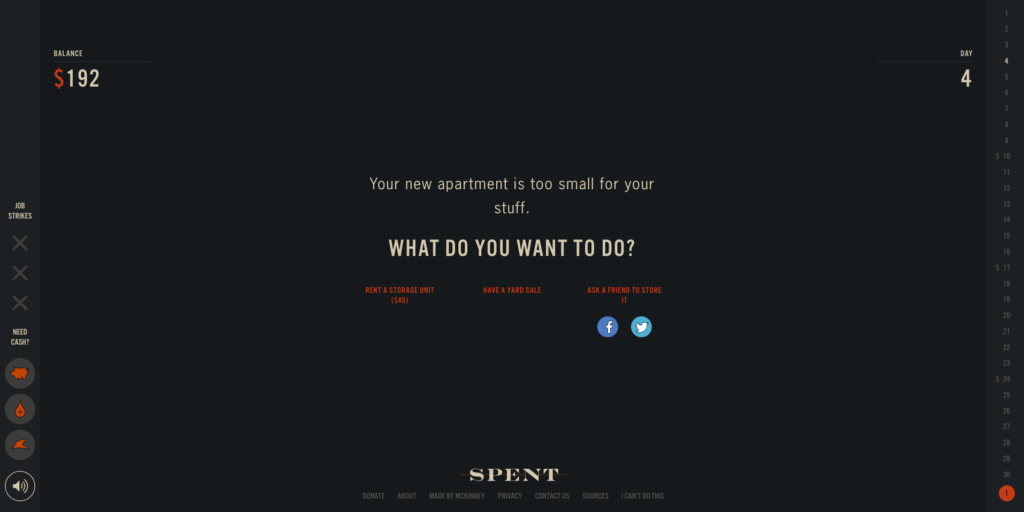Game: Spent
Author(s): McKinney, Urban Ministries of Durham
This game is about people who are unemployed and/or living below the poverty line. The types of play, or aesthetics that this game uses are narrative, challenge, and discovery.
The game is primarily using narrative aesthetic, as the game is text-based and creates a story of someone who is unemployed that the player must play through. The player makes different choices that decide the path of their game, and follows the formula of a choose-your-own-adventure type game that I think of when I think of narrative games. There is also an element of the challenge aesthetic, because the game itself is challenging you to make it through the month as best you can (see below). The goal is to try and get and keep as much money as possible, with the purpose of showing the player how hard it is to live below the poverty line. Most people will see this as a challenge to try and find the most efficient, or “best” path in the game. Finally, it can be argued that there is an element of discovery, as the type of people that this game is being marketed to are people who do not live under the poverty line. Because of this, the player is in “uncharted territory”, and is navigating a situation where they might have no idea what it’s like. This can be argued, but I think that the game is mostly narrative and challenge.
The game utilizes the MDAO framework to focus on the outcome of information, and the outcome of aesthetic. The purpose of the game is to inform and make aware the struggles of those living under the poverty line, which is what makes the outcome of the game a clear informational one. It also evokes emotions in the player by putting them in the position of someone who is unemployed and struggling, so that the player might feel empathy for these people, and might even feel closer to them. This would mean that the desired outcome of this game is also aesthetic. The mechanics and dynamics of the game are very straight-forward: you have a balance, and every day that you advance there is a new obstacle. The game will give you two or more options to handle the situation as best as you see fit, and the choices that you make effect how much you have in your bank account, and effect what might happen later on in the game. The mechanics are that the user chooses one of the choices given to them (see below), and the dynamics are how those choices effect how well they do in the game. I think that the designers made the mechanics and dynamics simple because they wanted the users to see that although it may look like the choices that these people face might seem obvious, but each choice can have major repercussions that may seem irrational or irrelevant to people who aren’t in that situation.
Example of challenge aesthetic in the game:

Example of the narrative aesthetic, as well as the mechanics and dynamics:




